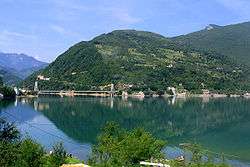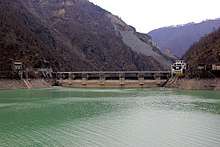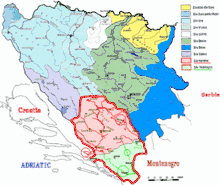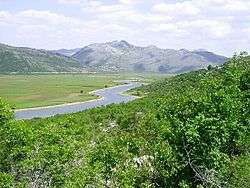Jablaničko lake
| Jablaničko Lake | |
|---|---|
 | |
| Location | Herzegovina |
| Coordinates | 43°41′N 17°51′E / 43.683°N 17.850°ECoordinates: 43°41′N 17°51′E / 43.683°N 17.850°E |
| Type | reservoir |
| Primary inflows | Neretva |
| Primary outflows | Neretva |
| Basin countries | Bosnia and Herzegovina |
| Max. length | 30 km (19 mi) |
| Max. width | 1,200 m (3,900 ft) |
| Surface area | 24 km2 (9.3 sq mi) |
| Average depth | 70 m (230 ft) |
| Max. depth | 80 m (260 ft) |
| Surface elevation | 270 m (890 ft) |
| Settlements | Jablanica, Konjic, Prozor-Rama |
Jablaničko lake (Bosnian: Jablaničko jezero) is a large artificially formed lake on the Neretva river, right below Konjic where the Neretva briefly expands into a wide valley. River provided lot of fertile, agricultural land there, before lake flooded most of it. The lake was created in 1953 after construction of[1] Jablanica Dam near Jablanica in central Bosnia and Herzegovina.
The lake has an irregular elongated shape. Its width varies along its length. The lake is a popular vacation destination in Bosnia and Herzegovina. Swimming, boating and especially fishing are popular activities on the lake. Many weekend cottages have been built along the shores of the lake. There are 13 types of fish in the lake's ecosystem.
However, the lake suffered from poor management of water and fisheries. Without any scientific and management plans or research, local fisheries and angling management introduced, alien, non-indigenous or non-native species, either deliberately or accidentally, which did more harm and damage than good. As the Neretva has many endemic and fragile species of fish that are near extinction, introductions of this invasive species, Pike Perch (Stizostedion lucioperca L.), completely destroyed native endemic and highly endangered fish like Strugač (Leuciscus svallize svallize Heck. et Kn.) or (Squalius svallize)[2] and Glavatica (Salmo marmoratus) (also known as Gonjavac).[3]
Gallery
 Jablanica lake at summer
Jablanica lake at summer Jablanicko Jezero
Jablanicko Jezero Jablanica dam
Jablanica dam
See also
Water bodies
Settlements
Protected environment and treasures
Nature and culture
References
- ↑ "Methodology and Technical Notes". IUCN - Watersheds of the World. Archived from the original on 2007-07-04. Retrieved 2009-07-15.
A large dam is defined by the industry as one higher than 15 meters high and a major dam as higher than 150.5 meters
- ↑ "Fishbase - Species Summary: Strugač". Fishbase. Retrieved 2009-07-14.
- ↑ "Living Neretva - biodiverzitet". WWF Panda. Retrieved 2009-07-14.

